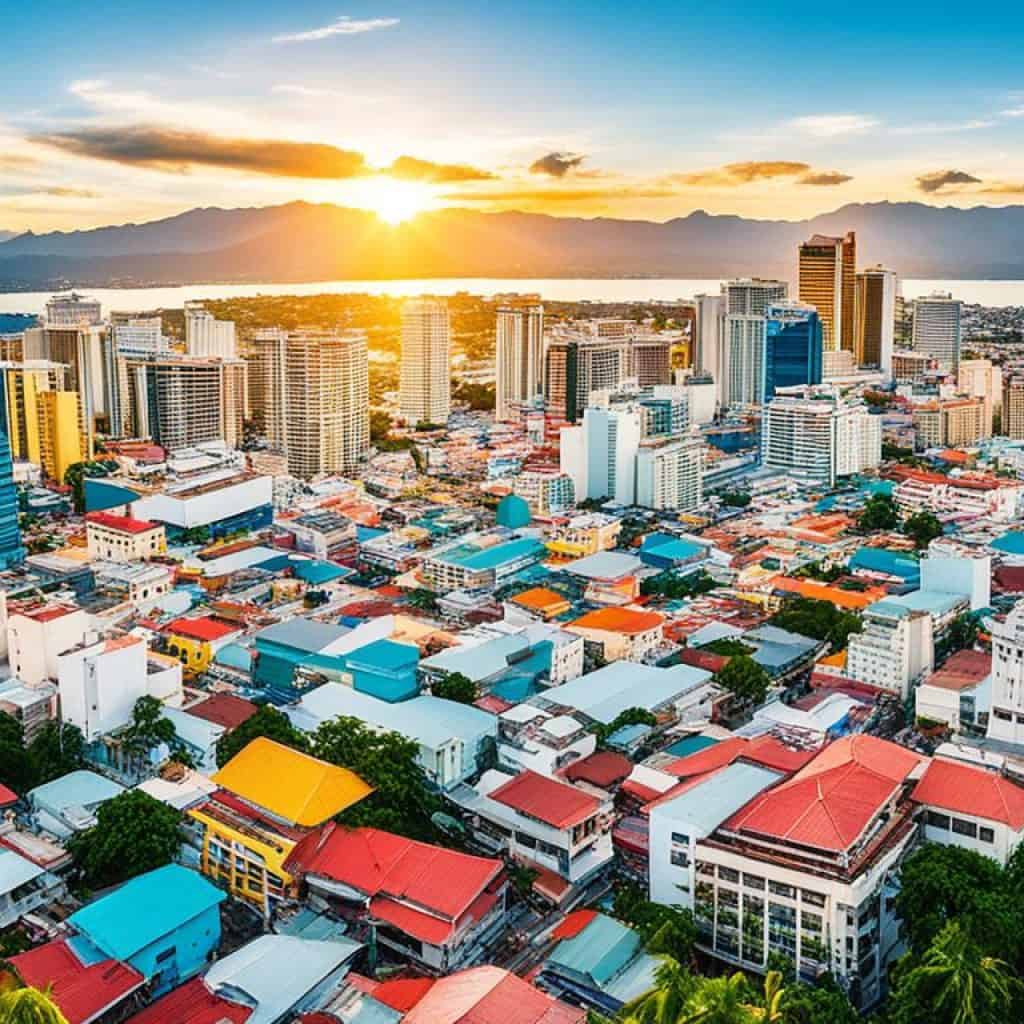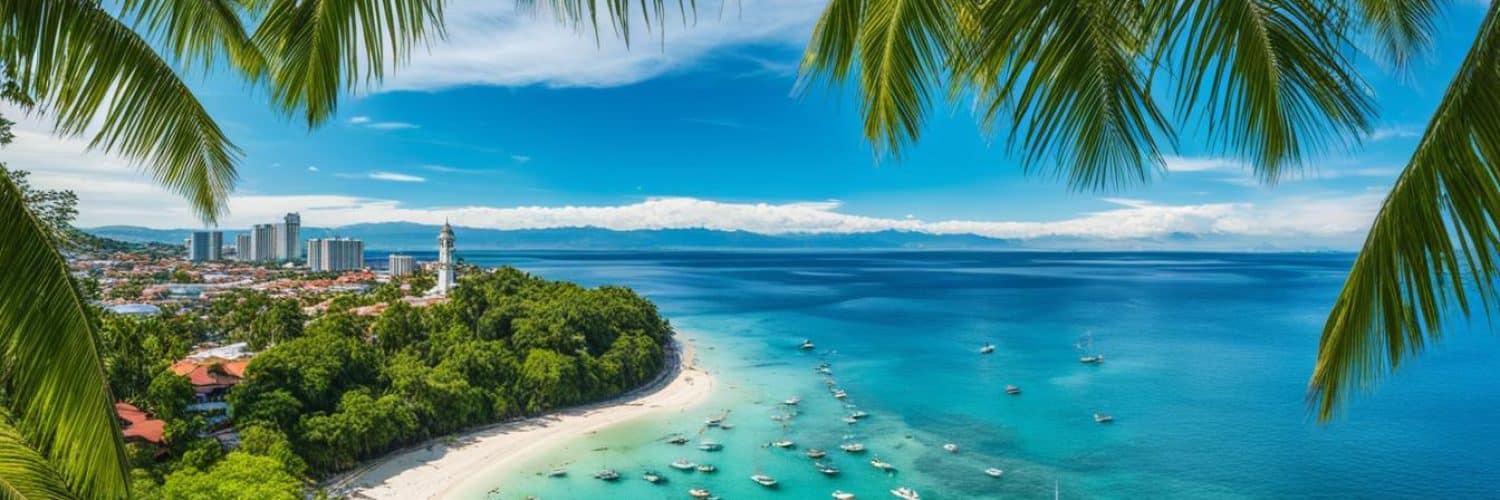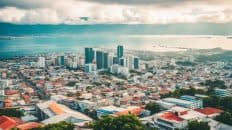Have you ever wondered if Cebu is an island? Well, let’s dive into the geography of Cebu and uncover the truth behind this captivating destination in the Philippines. Cebu is not just your average province, it’s a tropical paradise composed of a main island and various surrounding islands and islets.
Located in the Central Visayas region, Cebu is known as the “Queen City of the South” and is home to the bustling metropolis of Cebu City. With its breathtaking beaches, stunning natural landscapes, and vibrant culture, Cebu has become a popular tourist destination, attracting visitors from all over the world.
Key Takeaways:
- Cebu is a province in the Philippines, consisting of a main island and multiple surrounding islands and islets.
- Cebu is located in the Central Visayas region and is known as the “Queen City of the South.”
- The province covers a total area of 4,943.72 square kilometers and has a population of approximately 3.3 million.
- Cebu is renowned for its beautiful beaches, stunning natural landscapes, and rich cultural heritage.
- Join us as we explore the geography, history, attractions, and cuisine of this fascinating island province.
Geography of Cebu
Cebu, located in the central part of the Philippines, is a picturesque province that is part of the Visayas Island Group. Bounded by the Visayan Sea, Cebu is strategically situated between the islands of Negros and Leyte. Its breathtaking landscape is characterized by diverse topography that includes awe-inspiring mountain ranges, rolling hills, sprawling plateaus, and scenic coastal plains.
The province of Cebu boasts Osmeña Peak as its highest point, standing majestically at 1,072 meters above sea level. This magnificent peak offers panoramic views of the surrounding beauty. Cebu is also renowned for its numerous waterfalls, such as the enchanting Kawasan Falls, where the crystal-clear water cascades down lush green cliffs, creating a captivating oasis. Additionally, Cebu’s coastal areas are home to stunning coral reefs, attracting divers and nature enthusiasts from around the globe.
“Cebu’s geography is a testament to the wonders of nature, with its mountains, hills, plateaus, and coastal beauty. Whether you’re a hiking enthusiast searching for breathtaking vistas or a nature lover seeking to immerse yourself in the wonders of marine life, Cebu has something incredible to offer.”
Exploring the geography of Cebu is a truly immersive experience. From the tranquil beaches to the awe-inspiring peaks, there is no shortage of natural wonders to discover. Whether you’re embarking on a thrilling outdoor adventure or simply looking to unwind amidst nature’s beauty, Cebu’s diverse topography guarantees an unforgettable journey.
Cebu Island Facts
Cebu Island is the main island of the province of Cebu, located in the Central Visayas region of the Philippines. With a land area of approximately 4,943.72 square kilometers, Cebu Island ranks as the 20th largest province in the country. It is home to a diverse population of over 3 million people, making it the 5th most populous province in the Philippines.
The island’s vibrant economy contributes significantly to the growth of the region. Cebu Island is known for its thriving industries, including business process outsourcing, tourism, and manufacturing. The growth of these sectors has fueled the development of infrastructure and created employment opportunities for local residents.
Cebu Island is not only renowned for its economic prosperity but also for its rich historical heritage. The island is home to significant historical sites that attract visitors from around the world. One of the notable landmarks is Magellan’s Cross, located in downtown Cebu City. This iconic symbol marks the spot where Ferdinand Magellan, the Portuguese explorer, introduced Christianity to the Philippines in 1521.
Another prominent historical attraction on Cebu Island is the Basilica Minore del Santo Niño, a centuries-old church that houses the revered statue of the Santo Niño (Child Jesus). This religious relic holds great cultural and religious significance, as it is believed to be the oldest Catholic relic in the Philippines.
In addition to its historical sites, Cebu Island is blessed with natural beauty. The island boasts stunning beaches, such as the white sands of Moalboal and the picturesque shores of Bantayan Island. Waterfalls, such as Kawasan Falls, offer a refreshing escape for nature lovers. Visitors can also venture underwater to explore Cebu Island’s vibrant coral reefs, teeming with diverse marine life.
“Cebu Island is a true treasure trove of history and natural wonders, offering visitors a unique blend of cultural heritage and breathtaking landscapes.”
Whether you’re interested in history, nature, or simply experiencing the vibrant local culture, Cebu Island has something for everyone. Its rich heritage, economic significance, and captivating beauty make it a must-visit destination in the Philippines.
| Cebu Island Facts | Details |
|---|---|
| Land Area | Approximately 4,943.72 square kilometers |
| Population | Over 3 million people |
| Main Industries | Business process outsourcing, tourism, manufacturing |
| Historical Landmarks | Magellan’s Cross, Basilica Minore del Santo Niño |
| Natural Attractions | Beautiful beaches, waterfalls, coral reefs |
Cebu City: The Capital of Cebu
Cebu City, the capital of Cebu province, is a bustling metropolis located on the eastern coast of Cebu Island. As the largest city in the province, it serves as the main center of commerce, trade, education, and industry in the Visayas, one of the three main island groups in the Philippines.
Cebu City boasts a modern skyline that is a testament to its rapid growth and development. Tall buildings and vibrant street life define the city’s urban landscape, creating a dynamic and energetic atmosphere that visitors can’t help but be drawn to.
The city is not only a thriving economic hub but also a treasure trove of historical landmarks and cultural heritage. The Cebu Metropolitan Cathedral stands as an architectural marvel and a symbol of the city’s deep-rooted Catholic faith. The Magellan Monument commemorates the arrival of Ferdinand Magellan, marking the beginning of Spanish colonization in the Philippines.
“Cebu City is a vibrant and diverse destination that seamlessly blends tradition and modernity. Its historical landmarks, such as the Cebu Metropolitan Cathedral and the Magellan Monument, provide insight into the city’s rich heritage.”
Being a major transportation hub, Cebu City is well-connected to other parts of the province and the country. The Mactan-Cebu International Airport, the second busiest airport in the Philippines, welcomes both domestic and international flights, making it easy for travelers to reach the city.

Exploring Cebu City
When in Cebu City, visitors can explore the city’s diverse neighborhoods, each offering a unique charm and experience. The historic district of Colon Street takes you back in time with its well-preserved Spanish colonial architecture, while the bustling Fuente Osmeña Circle is a popular gathering place for locals and visitors alike.
Malls and shopping centers dot the city, catering to the needs and wants of shoppers. From luxury brands to local crafts and souvenirs, Cebu City has it all. For a taste of the local cuisine, head to Carbon Market, where you can find a variety of fresh produce, street food, and local delicacies.
Cebu City: A Gateway to Adventure
While Cebu City offers an urban experience, it also serves as a gateway to thrilling adventures. Just a short drive from the city, you’ll find picturesque waterfalls and mountain ranges, perfect for nature enthusiasts and outdoor lovers. The nearby islands and beaches offer stunning views and pristine waters, ideal for swimming, snorkeling, and diving.
Cebu City truly encapsulates the spirit of the province. From its economic significance to its historical landmarks and proximity to natural wonders, it is a destination that caters to a wide range of interests and preferences. Whether you’re seeking cultural insights, urban experiences, or thrilling adventures, Cebu City has something to offer for everyone.
Historical Significance of Cebu
Cebu holds a deep historical significance due to the arrival of Ferdinand Magellan in 1521, which marked the beginning of Spanish colonization in the Philippines. Magellan, in his quest for new trade routes, landed in Cebu and formed a friendly alliance with the local chieftain, Rajah Humabon. This pivotal event led to the introduction of Catholicism to the island, making Cebu the birthplace of Christianity in the Philippines.
Today, Cebu boasts several historic sites that bear witness to its rich past. One such iconic landmark is Magellan’s Cross, a symbol of the first Catholic baptism in the country. Visitors can also explore Fort San Pedro, a well-preserved Spanish fortress that served as a military defense structure during the colonial era. These historical attractions attract tourists and history enthusiasts from around the world, offering a glimpse into Cebu’s significant role in shaping the nation’s history.
Cebu’s historical sites and artifacts are not only symbols of the past but also reminders of the enduring cultural heritage that continues to thrive in the present. They serve as a testament to the resilience and spirit of the Filipino people.
| Historical Sites in Cebu | Description |
|---|---|
| Magellan’s Cross | A wooden cross planted by Ferdinand Magellan upon his arrival and the site of the first Catholic baptism in the Philippines. |
| Fort San Pedro | A Spanish fortress dating back to the 16th century, built to defend against pirate attacks and is now a historical park and museum. |
| Basilica Minore del Santo Niño | An important religious landmark housing the image of the Santo Niño, a revered religious icon brought by Magellan to Cebu. |
| Lapu-Lapu Shrine | A monument dedicated to Datu Lapu-Lapu, the native chieftain who led the resistance against Magellan’s forces in the Battle of Mactan. |
| Colon Street | The oldest street in the Philippines, named after Christopher Columbus (Colon) and lined with heritage buildings and historical sites. |
Economic Importance of Cebu
Cebu plays a significant role in the economy of the Philippines. As one of the most developed provinces in the country, Cebu serves as a major economic hub in the Visayas region. The province’s diverse economy is driven by several sectors that contribute to its growth and development.
Business Process Outsourcing
Cebu City, the capital of Cebu, is home to numerous call centers and IT parks, making it a prominent destination for the country’s business process outsourcing (BPO) industry. The BPO sector in Cebu provides employment opportunities for thousands of individuals and contributes significantly to the local economy.
Tourism
Cebu’s natural beauty, pristine beaches, and cultural attractions make it a popular tourist destination. The tourism industry is a major source of revenue for the province, attracting millions of visitors from around the world each year. Tourists are drawn to Cebu’s stunning beaches, diving spots, historical sites, and vibrant festivals, such as the renowned Sinulog Festival.
Manufacturing
Cebu is also known for its thriving manufacturing sector, which encompasses various industries, including electronics, furniture, garments, and food processing. The province’s strategic location, well-developed infrastructure, and skilled workforce make it an attractive destination for manufacturing companies. Cebu’s manufacturing sector contributes significantly to the province’s economy and provides employment opportunities for many locals.
Agriculture
Agriculture is another important sector in Cebu’s economy. The province is known for its agricultural products, including coconut, corn, rice, and various fruits and vegetables. The fertile lands and favorable climate create favorable conditions for agricultural production, supporting the livelihoods of many farmers and contributing to the province’s food security.
Overall, Cebu’s economy is dynamic and diverse, driven by sectors such as business process outsourcing, tourism, manufacturing, and agriculture. These industries have played a vital role in the province’s economic growth, creating job opportunities and contributing to the overall development of the Philippines.
Natural Attractions in Cebu
Cebu is a paradise for nature lovers, boasting a plethora of natural attractions that will leave you in awe. From the pristine beaches to the enchanting waterfalls, Cebu offers a diverse range of natural wonders to explore and enjoy.
Beaches
When it comes to beaches, Cebu has some of the best in the Philippines. Malapascua Island, located in the northern part of Cebu, is renowned for its stunning white sand beaches and crystal-clear waters. It is a popular destination for diving enthusiasts, with its abundant marine life and vibrant coral reefs.
Bantayan Island, on the other hand, offers a more laid-back beach experience. The island’s long stretches of powdery white sand and turquoise waters provide the perfect backdrop for relaxation and sunbathing.
Waterfalls
Cebu is also home to breathtaking waterfalls that will leave you mesmerized. Kawasan Falls, located in Badian, is a three-tiered waterfall nestled amidst lush greenery. Its cascading turquoise waters are a sight to behold and a popular spot for canyoneering and swimming.
Tumalog Falls, situated in Oslob, is another enchanting waterfall that draws visitors with its fairy-tale-like beauty. The water gently cascades over limestone formations, creating a mesmerizing curtain of water.
Underwater World
Explore the vibrant underwater world of Cebu through its abundant coral reefs and diverse marine life. Snorkeling and diving enthusiasts can explore the colorful coral gardens and encounter various marine species, including tropical fish, sea turtles, and even whale sharks.
Whether you’re a beach lover, a waterfall seeker, or an underwater adventurer, Cebu has something for everyone. Immerse yourself in the natural beauty of Cebu and create unforgettable memories in this tropical paradise.
Cultural Heritage of Cebu
Cebu, known for its vibrant festivals, rich traditions, and historical sites, has a remarkable cultural heritage that showcases the province’s deep-rooted history and identity. At the heart of Cebu’s cultural celebrations is the world-renowned Sinulog Festival, a colorful and lively spectacle that pays homage to the Filipino people’s conversion to Christianity. The Sinulog Festival attracts thousands of locals and tourists alike, who gather to witness the street dances, religious processions, and grand parades that fill the city with energy and excitement.
But Cebu’s cultural heritage extends far beyond the Sinulog Festival. The province is home to several historical landmarks that serve as testaments to its rich past. One notable site is the Magellan’s Cross, a significant symbol of the arrival of Christianity in the Philippines. Visitors can also explore the awe-inspiring Basilica Minore del Santo Niño, the oldest Roman Catholic church in the country. These historical sites not only offer a glimpse into Cebu’s past but also provide a deeper understanding of the nation’s cultural and religious roots.
“Cebu’s cultural heritage is a treasure trove of traditions, stories, and legacies that have shaped the province’s identity. Through cultural events and activities, the locals of Cebu actively preserve and promote their heritage, ensuring that the traditions and customs are passed down to future generations.”
Embracing their cultural heritage, the people of Cebu actively participate in events and activities that celebrate their traditions. Folk dances, traditional music performances, and local handicraft exhibitions are just some of the ways in which Cebuanos showcase their vibrant culture to the world. These cultural events not only entertain and educate but also serve as opportunities for locals and visitors to immerse themselves in the uniqueness of Cebuano culture.
Festivals in Cebu
Cebu is a province of festivals, with various celebrations held throughout the year. In addition to the grand Sinulog Festival, other significant festivals include:
- Kadaugan sa Mactan Festival: Commemorating the Battle of Mactan, this festival showcases reenactments and cultural performances that honor Lapu-Lapu, the indigenous chieftain who defeated Ferdinand Magellan.
- Tinabuay Festival: Celebrated in Dalaguete, this harvest festival highlights the town’s agricultural heritage through street dances, processions, and a grand display of local produce.
- Pasigarbo sa Sugbo Festival: Showcasing the diverse cultural traditions of Cebu, this festival features performances, exhibitions, and competitions that highlight the talents and skills of the different towns and cities in the province.
These festivals not only serve as a platform to promote Cebu’s cultural heritage but also contribute to the local economy by attracting tourists and fostering commerce.
| Festival | Date | Description |
|---|---|---|
| Sinulog Festival | Third Sunday of January | Celebrates the conversion of the Filipino people to Christianity, featuring vibrant street dances, religious processions, and grand parades. |
| Kadaugan sa Mactan Festival | Every April 27 | Commemorates the Battle of Mactan and honors Lapu-Lapu, the indigenous chieftain who defeated Ferdinand Magellan. |
| Tinabuay Festival | May 1 | A harvest festival that showcases the agricultural heritage of Dalaguete, featuring street dances, processions, and a grand display of local produce. |
| Pasigarbo sa Sugbo Festival | August 6 | Highlights the diverse cultural traditions of Cebu, featuring performances, exhibitions, and competitions that showcase the talents and skills of the different municipalities and cities in the province. |
Cebu’s cultural heritage is a source of pride and inspiration for its residents, as well as an invitation for visitors to explore, experience, and appreciate the province’s rich traditions. Whether it’s joining the vibrant revelry of the Sinulog Festival, visiting historical landmarks, or witnessing the cultural performances, a journey through Cebu’s cultural heritage promises an immersive and memorable experience.
Development and Infrastructure in Cebu
Cebu has made significant strides in development and infrastructure in recent years, positioning itself as a major economic and tourist hub in the Philippines. The province has invested in various projects to enhance connectivity and facilitate economic growth, transforming Cebu into a thriving destination for businesses and travelers alike.
One key area of development is transportation infrastructure. Cebu boasts a well-connected road network, allowing easy access to different parts of the province. Moreover, the Mactan-Cebu International Airport, the second busiest airport in the country, has undergone extensive expansions and upgrades, catering to the increasing number of domestic and international flights.
Cebu City, the capital of the province, has witnessed the establishment of modern business districts such as the Cebu IT Park and the Cebu Business Park. These dynamic and vibrant urban centers attract local and foreign investments, providing numerous opportunities for business growth and employment.
“The development and enhancement of infrastructure in Cebu have created a conducive environment for economic progress and improved the overall quality of life in the province.”
Furthermore, Cebu has not only focused on transportation and business infrastructure but also on the development of cultural and tourism facilities. The province boasts a multitude of tourist attractions, historical landmarks, and natural wonders that have all been carefully preserved and developed to cater to the needs of tourists and visitors.
Overall, Cebu’s commitment to development and infrastructure has laid a strong foundation for economic prosperity and sustainable growth. The continuous improvements in transportation, business, and tourism sectors showcase the province’s dedication to position itself as a premier destination for investment, commerce, and leisure in the Philippines.
Cuisine and Culinary Delights in Cebu
Cebu is renowned for its delectable cuisine, offering a tantalizing array of flavors that will satisfy any food lover’s palate. From mouthwatering roasted delicacies to savory seafood dishes, Cebu’s culinary scene is a vibrant blend of tradition and innovation. One of the province’s most iconic dishes is Cebu lechon, a whole roasted pig that is roasted to perfection, resulting in tender meat and crispy skin. The combination of succulent meat and flavorful seasonings makes Cebu lechon a must-try delicacy for visitors.
Seafood enthusiasts will be delighted by Cebu’s abundance of fresh and dried seafood options. Dried danggit, a popular pasalubong item, features rabbitfish that has been dried and seasoned with local spices. This savory treat is best enjoyed with steaming white rice and a side of vinegar for dipping.
Another Cebuano specialty is dried pusit, or dried squid. These dried squid strips are a favorite snack among locals and tourists alike. With their chewy texture and distinct taste, they offer a unique flavor experience that captures the essence of Cebu’s coastal cuisine.
Cebu is also known for its delightful delicacies that are perfect for satisfying your sweet tooth. Otap, a crispy and sweet pastry made from flour, shortening, and sugar, is a popular treat that pairs well with a cup of hot coffee. Another local favorite is the rosquillos, a bite-sized cookie that is crispy on the outside and soft on the inside.
To truly experience the diverse flavors of Cebu, be sure to explore the local markets, food stalls, and restaurants that showcase the region’s culinary treasures. From street food to fine dining, Cebu offers a wide range of dining options to suit every taste and budget.
Indulge in the diverse flavors and culinary delights that Cebu has to offer. From the smoky and succulent Cebu lechon to the savory dried seafood and sweet delicacies, the province’s cuisine is a true reflection of its rich culinary heritage.

Must-Try Cebuano Delicacies
- Otap – A sweet and crispy pastry that is perfect for snacking.
- Rosquillos – Bite-sized cookies that melt in your mouth.
- Dried Danggit – Savory dried rabbitfish, a popular pasalubong item.
- Dried Pusit – Chewy and flavorful dried squid that captures the essence of Cebu’s coastal cuisine.
Tourism in Cebu
Welcome to Cebu, a paradise for tourists seeking a perfect blend of history, natural beauty, and thrilling adventures. With a plethora of attractions and activities, Cebu has something for everyone. Whether you’re a history buff, a nature lover, or an adventure seeker, you’ll find plenty to do and explore in this captivating province.
Historical Sites and Cultural Heritage
Immerse yourself in Cebu’s rich history by visiting iconic sites such as Magellan’s Cross and Fort San Pedro. Stand in awe as you discover the remnants of Ferdinand Magellan’s arrival, which marked the beginning of Spanish colonization in the Philippines. Take a stroll through the historic streets and experience the blending of Spanish and Filipino cultures, depicted in the architecture, food, and traditions imprinted across the province.
Natural Beauty and Outdoor Adventures
Cebu boasts breathtaking natural beauty, including pristine beaches, majestic waterfalls, and captivating dive sites. Soak up the sun and unwind on the white sandy beaches of Malapascua Island and Bantayan Island, surrounded by crystal-clear waters. Dive into adventure by exploring the vibrant underwater world, teeming with colorful coral reefs and diverse marine life. For adrenaline junkies, don’t miss the chance to experience the adrenaline rush of canyoneering in Kawasan Falls or go island hopping to discover Cebu’s hidden gems.
Vibrant Nightlife and Shopping
As the sun sets, Cebu comes alive with its vibrant nightlife. Experience the energy and excitement as you explore lively bars, clubs, and entertainment venues. Savor the local cuisine and feast on the world-famous Cebu lechon, a mouthwatering roasted pig that embodies the flavors of the region. Indulge in shopping therapy at bustling markets, bazaars, and mega malls, where you can find a range of local products, arts, and crafts to take home as souvenirs.
The Cebu Experience
From historical landmarks to natural wonders, Cebu offers a diverse range of experiences that will leave you enchanted. Create unforgettable memories as you dive into the province’s vibrant culture, explore its scenic landscapes, and embrace thrilling adventures. Cebu invites you to embark on a journey of discovery and enjoy the warm hospitality of its people.
| Popular Tourist Spots in Cebu | Highlights |
|---|---|
| Magellan’s Cross | Historical landmark marking the arrival of Ferdinand Magellan |
| Fort San Pedro | Ancient fort offering panoramic views and a glimpse into Cebu’s past |
| Malapascua Island | Pristine beaches and world-class diving sites |
| Bantayan Island | Tranquil paradise with powdery white sand beaches |
| Kawasan Falls | Adventurous canyoneering and stunning turquoise waterfalls |
| Cebu IT Park | Modern business district with vibrant nightlife and dining options |
Discover the wonders of Cebu, and let its beauty and charm leave an indelible mark on your heart. This enchanting province is ready to welcome you with open arms and unforgettable experiences.
Accommodation and Transportation in Cebu
Cebu offers a wide range of accommodation options for visitors, from luxury resorts to budget-friendly hotels and guesthouses. Whether you prefer a beachfront retreat or a cozy city hotel, Cebu has something for everyone. Some popular accommodation choices in Cebu include:
- Luxury Resorts: Experience ultimate relaxation and indulgence at renowned resorts like Shangri-La Mactan Resort and Spa or Crimson Resort and Spa. These luxury properties offer lavish amenities, stunning views, and impeccable service.
- Budget-Friendly Hotels: If you’re traveling on a budget, Cebu has plenty of affordable yet comfortable hotels to choose from. Places like Express Inn, Cebu R Hotel, and Sampaguita Suites offer clean and cozy rooms at wallet-friendly prices.
- Guesthouses and Homestays: For a more immersive experience, consider staying at a guesthouse or homestay in Cebu. These accommodations provide a glimpse into the local way of life and often offer home-cooked meals, making you feel like a part of the community.
In terms of transportation, Cebu has a well-developed road network, making it easy to explore different parts of the province. Public transportation such as buses and jeepneys is readily available for getting around Cebu City and its neighboring towns. It’s a convenient way to immerse yourself in the local culture and interact with fellow travelers. Additionally, tourists can hire private vehicles or arrange for guided tours to make their travel experience more convenient and tailored to their preferences.
Top Accommodation Options in Cebu
| Accommodation Type | Recommended Options |
|---|---|
| Luxury Resorts | Shangri-La Mactan Resort and Spa, Crimson Resort and Spa |
| Budget-Friendly Hotels | Express Inn, Cebu R Hotel, Sampaguita Suites |
| Guesthouses and Homestays | CEBU GUESTHOUSE – House of SMITH, Learning Lodge Cebu |
Experience the warm hospitality and enjoy a comfortable stay in Cebu as you explore all the province has to offer. From beautiful accommodations to convenient transportation options, Cebu is ready to welcome you with open arms.
Conclusion
In conclusion, Cebu is indeed an island and a province in the Philippines. Located in the Central Visayas region, Cebu offers a diverse range of attractions and experiences for tourists. Its stunning landscapes, including pristine beaches and picturesque waterfalls, make it a haven for nature lovers and beach enthusiasts. And with its rich cultural heritage and historical sites, such as Magellan’s Cross and Fort San Pedro, Cebu provides a fascinating glimpse into the country’s history and traditions.
But Cebu is not just about natural beauty and history. It is also a thriving economic hub, contributing significantly to the country’s economy. With its booming business process outsourcing industry, modern infrastructure, and vibrant tourism sector, Cebu offers a wealth of economic opportunities.
Whether you’re looking to relax on beautiful beaches, indulge in delicious local cuisine like the famous Cebu lechon, or explore the province’s rich cultural heritage, Cebu has something for everyone. So, if you’re planning your next vacation, consider Cebu as your destination and immerse yourself in the beauty, culture, and warmth that this remarkable island has to offer.


















Add comment